Fly fishing for salmon in Autumn usually provides the best chance of catching one of these beautiful fish on the Welsh Dee. It’s also a magical time of the year to be out fishing as the leaves turn golden in the Dee Valley.
There’s nothing quite like the feeling when a salmon takes your fly and powers off downriver making your reel scream.
Catching salmon on the fly puts a BIG GRIN on any angler’s face.

In this comprehensive guide, we’ll explore the essentials of fly fishing for salmon in autumn, including recommended flies, tackle requirements, leader setups, ideal fishing times, river conditions and pool selection at Llangollen.
So, let’s start the journey to help you experience this unforgettable experience…
Why is autumn a good time for fly fishing for salmon?
Nowadays the main run of Atlantic salmon into the Welsh Dee occurs during the summer months (June to August). However, during dry summers salmon tend to hold in the beats below Chirk awaiting the arrival of wetter weather in September.
Rising river levels and lower autumn temperatures encourage salmon to run upriver to their spawning grounds. Offering you the chance to see and catch one of these powerful fish.
Now, let’s take a look at the…
Essential tackle for salmon fly fishing in Autumn
Selecting a salmon fly rod
The size of the river you are fishing should be reflected in your choice of double-handed fly rod. A 13 to 14ft (9# to 10#) double-handed fly rods are my favourite for medium rivers like the Welsh Dee because you’ll be able to swing the fly across lies and effortlessly lift the line from the water when casting.
Furthermore, I occasionally use an 11-foot Orvis Clearwater switch rod for salmon fly fishing on the upper beats of the Welsh Dee because it is easier to handle where the river is narrower. These lighter rods enable you to deliver the fly with greater precision and stealth, which is essential on the narrow upper beats.
Fly reels and their role
Like fly rods, there are a multitude of fly reels for salmon fishing on the market. My preference is for a large arbour design that holds the fly line and at least 150m of backing and has a smooth drag system.
If your budget is tight, I would spend less on the reel and more on the fly rod and line because these will be more beneficial to your casting when starting.
Choosing the salmon fly line(s)
The choice of salmon fly line is the most confusing element of the fly fishing kit for beginners and seasoned salmon anglers. There is so much choice covering a variety of fishing styles, river and weather conditions.
In Autumn higher river flows it pays to have a floating line and range sinking tips in different densities to cover the changing water levels and temperatures. I find this can be covered on the Welsh Dee using a multi-tip fly line system, for example:
- GAELFORCE Equalizer EMT Multi-Tip
- Airflo Tactical Quick Spey Multi-Tip Kit
- RIO INTOUCH VERSITIP 2 FLY LINE
The benefit of this approach is that I can travel light (one rod and reel) and fish a lot of the river in a day in search of salmon.
Leaders, Tippets and knots for salmon fishing
A well-constructed leader is an important part of the salmon fly fishing set-up that is often overlooked. A good leader setup ensures the fly turns over nicely on every cast. So, the current doesn’t have to straighten everything out before the fly is fishing correctly.
Here’s a breakdown of a winning leader setup for your fly line:
Leader Strength:
Match the tippet strength to the size of the salmon you’re targeting and the prevailing water conditions. On the Welsh Dee, I normally use a fluorocarbon leader with a tippet-breaking stain between 13 and 20 lbs.
Leader Length:
The length of leader I use depends on the type of fly line I’m fishing:
- 12 to 15 ft fluorocarbon tapered leader for a floating line because facilitates a natural fly presentation and reduces the risk of spooking salmon in clear water.
- 9ft tapered leader intermediate line.
- 6ft leader for a medium sinking line.
- 3 – 4ft leader for fast sinking lines and heavy tube flies.
Knots:
It’s important to use robust and reliable knots to attach the leader to the fly line and fly, ensuring they can withstand the powerful runs of salmon.
Loop-to-loop connections between the fly line and leader make for easy line changes. To connect the leader to the fly line I use the Perfection Loop knot.
To attach the fly to the tippet I prefer to use the Rapala Knot because I believe this non-slip loop knot enhances fly movement and lifelike appearance.
Now, let’s look at the business end of the set-up for autumn salmon fly fishing…
Which salmon fly for Autumn?
Choosing the appropriate flies for autumn salmon fishing on the Welsh Dee can substantially boost your chances of success. However, regardless of the pattern, don’t overlook the significance of its size, as well as the pace and depth at which it is fished.
As a result, I believe that having a restricted number of patterns tied on singles, doubles, and tubes of varied densities (plastic, aluminium, copper, and tungsten) is preferable to having a box full of an infinite array of patterns.
Traditional back-end patterns include flies in orange, vibrant red and claret tones; perhaps something about these colours provokes resident fish into taking the fly.
Here are my favourite fly patterns that have helped me catch fish on the Welsh Dee and other rivers:
Red Ally’s Shrimp
A red fly is known to be a very effective pattern for salmon that have been in the river for a while. On the Welsh Dee, the red Ally’s shrimp has brought me plenty of success and is often the pattern I try first in autumn.
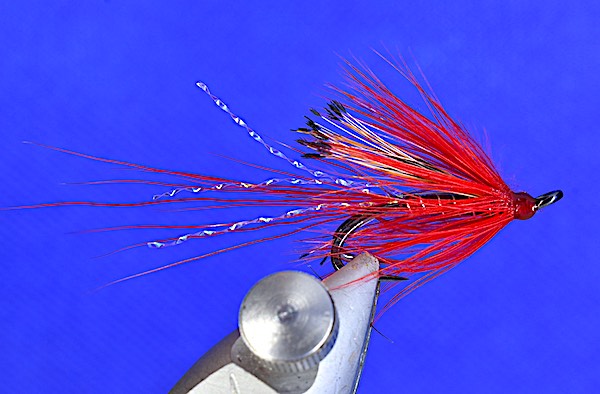
- Hook – Nordic double #12 to #8
- Thread – red 8/0
- Tail – red bucktail & crystal flash
- Body rear – red floss
- Body front – black floss
- Rib: medium silver wire
- Wing – golden pheasant tippet
- Hackle – red cock feather
When river conditions dictate a tube fly is needed, I would call upon a Red Francis pattern tied on a bottle tube.
Next up is the…
Cascade Salmon fly
When I spot fresh salmon running, I start fishing by tying on a Cascade double of tube fly with its vivid orange, yellow and black colour scheme because I don’t think there are many better patterns for that scenario.
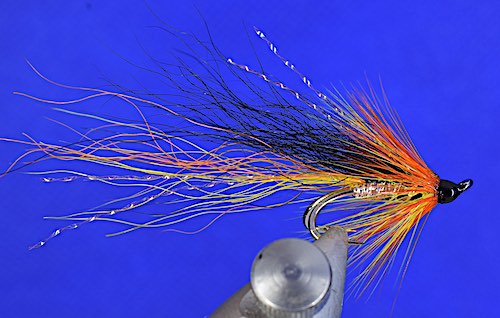
- Hook – Nordic double #12 to #8
- Thread – Black 8/0
- Tag & Rib – Medium oval tinsel
- Tail – yellow & flame orange bucktail, 2 strands of crystal flash
- Body rear – Holographic silver tinsel
- Body front – black thread
- Wing – Arctic Fox & 2 strands of crystal flash
- Hackle – orange cock over yellow cock
Also, it’s a good fly pattern that works in various water conditions.
Willie Gunn
The Willie Gunn tied with a gold or silver body is another traditional fly that I use for catching autumnal salmon. It works well when tied on tubes and double hooks.

- Hook – Gold double #12 to #8
- Thread – Red 8/0
- Body – Gold tinsel
- Rib – Medium black wire
- Wing – Blend of yellow, orange & black bucktail fibres
- Cheeks – Jungle cock feather
On mild autumnal days, I prefer to fish a Willie Gunn tied on a small double hook on a sink tip. However, when the river is running high and cold, I favour a tube version.
Black & Silver Ally’s Shrimp
At the other end of the spectrum, a Black and Silver Ally’s shrimp (#14 to 10 doubles) has brought me plenty of success in autumn when the river is running clear.
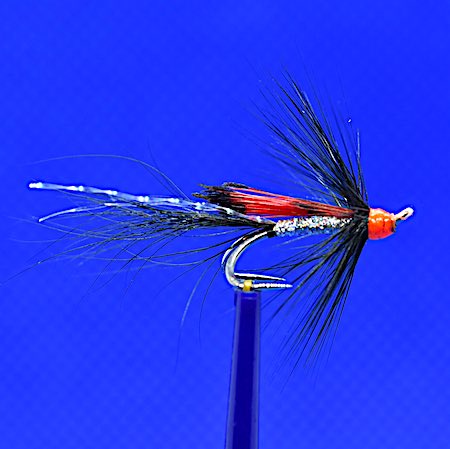
- Hook – Nordic double #12 to #8
- Thread – Fluorescent orange 8/0
- Tail – black squirrel & silver flash
- Body – silver braid
- Wing – Red pheasant tippet
- Hackle – black cock feather
Finally, my selection would be incomplete without a fly with a long wing that trails 1 – 3 inches behind the main body of the fly…
Sunray Shadow
I use Sunray Shadows when water temperatures have remained warm in the autumn months and the river is close to its summer level. They are effective when the salmon are active and inclined to follow or chase a fly.
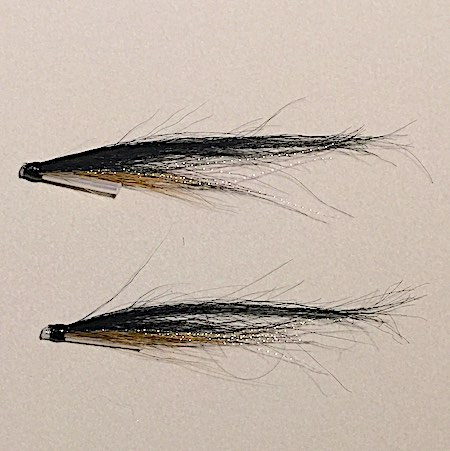
Sunray Shadow
- Tube – 1-inch plastic
- Thread – Black 8/0
- Tail under – yellow bucktail topped with crystal flash
- Tail (over) – goat hair
Above the fish, Sundays appear as a large dark silhouette that often triggers a violent reaction. They can be frustrating to fish because salmon will often chase the fly across the pool and swirl or jump behind it without taking the fly.
Sunrays frequently perform best when retrieved quickly on a floating line in slow-moving pools, but don’t forget to switch up the retrieval pace because fishing it slowly can also yield positive results. However, it can be an exciting method to use with explosive takes.
There are also many more tried and trusted salmon flies, such as Snaeldas, Garry Dog, Junction Shrimp, Park Shrimps, Monkeys, Posh Tosh and so on. However, I prefer to stick to the patterns described above and concentrate my efforts on fishing them at various depths and speeds.
Autumn salmon fly fishing tactics
The best fishing is likely to occur as the river drops and clears after a flood. However, on the Welsh Dee, the first flood after a long dry period is often disappointing because so much silt is purged from the river. Salmon are sometimes reluctant to run in this unclean water and even less willing to take a fly.
Catches improve as water levels settle a day or two later, depending on the river you are fishing. Salmon fishing has no hard and fast rules, just general principles.
So, here are my salmon fly fishing tips for the Welsh Dee…
- Instead of spending too much time fishing in one pool, cover as much water as possible. If there is “taking” salmon, it is either hooked on the first or second run through the pool.
- Examine the pool for potential salmon lies before casting a line and concentrate your efforts in those places as you fish through the pool.
- In autumn, most pools on the Welsh Dee can be effectively fished with a 15ft intermediate or sink tip and a floating line. If I don’t get a response on the first run through the pool, I usually switch to a setup that will fish the fly deeper on the second run-through. By using a heavier fly or a faster sink tip.
- In the autumn, my first preference is to begin fishing with a fly that has some red in its pattern. If it doesn’t work, I’ll try one of the other autumn fly patterns mentioned above.
- Vary the depth and pace at which the fly is presented; conditions typically change during the day, and what works in the morning may not work as well after lunch.
- It’s sometimes better to hold the fly over a lie and move the rod to give it some life than to swing it across the lie. Additionally, stripping the fly slowly through areas of dead water can lure a salmon – I find a smooth steady retrieve works well.
Fly fishing for salmon will be challenging. So, don’t let slow days discourage you; persistence will pay off with an amazing fish and an unforgettable experience.
Just…
Don’t get caught out using the same fly, set-up and approach all day!
How to find a good salmon pool?
Fly fishing for salmon is an exciting pursuit, but success often hinges on locating the prime pools and spots where they congregate, rest, and hide while making their journey upriver to spawn.
If you are fishing without a guide to point out these places, it’s crucial to understand the river features that provide ideal salmon lies and how to locate these promising fishing pools.
Salmon Pool Characteristics
Firstly, identifying river characteristics (flow, depth and structure) that attract salmon is vital to their location.
Flow:
Salmon seek areas with a comfortable balance between the current’s speed and their own energy expenditure. Pools with moderate to slow flows are attractive to salmon as they provide a suitable environment for resting. Look for spots where the current is not too strong, allowing salmon to conserve energy while resting.
Depth:
Salmon favour pools with varying depths and underwater structures. Deep pools offer a refuge from predators and can provide cooler temperatures during warmer seasons.
Structure and Cover:
Submerged structures like rock ledges, boulders, fallen trees, overhanging bank vegetation and deep undercut banks provide shelter and hiding spots for salmon. These structures provide resting places (lies) with a sense of security and protection from strong currents.
Temperature & Oxygen levels:
Salmon are sensitive to water temperature. Cooler waters are more appealing to them, especially during warmer months. Look for pools where cold water sources, such as tributaries or springs, feed into the river. These temperature differentials can attract salmon seeking optimal conditions for their journey.
Well-oxygenated water is essential for salmon. Pools with aeration, such as those created by riffles or small waterfalls, attract salmon that are seeking areas with high oxygen content. These areas are not only vital for resting but also support their overall health when the water temperature rises.
Specific Features of a Salmon Pool
Once you’ve identified the general characteristics that attract salmon, understanding specific features within a pool becomes crucial for successful fly fishing.
Migration Barriers:
Salmon prefer pools located just below natural obstacles like waterfalls or rapids. These areas provide resting spots before taking on the strenuous effort of ascending the obstacle. These pools are often referred to as “holding pools” and can be excellent locations for fly fishing.

Seams and Eddies:
The seam is the boundary between fast and slow-moving water, and eddies are circular currents that form behind obstructions like boulders and fallen trees. These spots offer a haven for salmon, as they require less energy to hold their position in these slow-moving waters. They are perfect locations to target when fly fishing for salmon.
Boulder Gardens:
Many rivers have sections with a high concentration of boulders or large rocks. These areas create pockets of calm water where salmon like to rest and recover from their upstream journey. They can also serve as ideal ambush points for anglers targeting salmon.
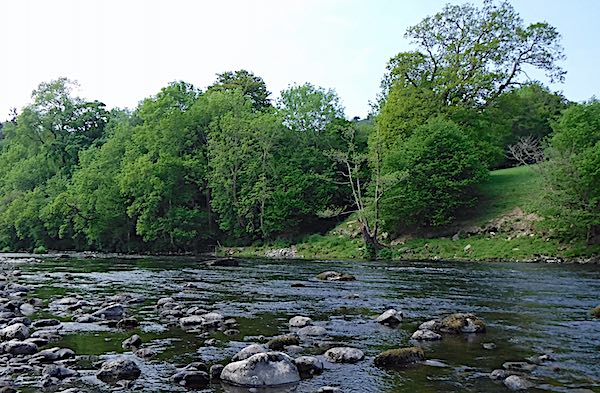
Riffles and Runs:
Although salmon prefer pools, they will often move through riffles and runs when migrating upriver. These areas can be suitable for fly fishing, especially if you’re targeting salmon that are actively on the move. Look for slower pockets within these faster-moving sections of the river.
Pool Tails:
The tail of a pool, where the water begins to speed up and shallow, is another excellent spot. Salmon often rest here before moving upriver. These areas can be tricky to fish, but with the right presentation and gear, they can yield fantastic results.
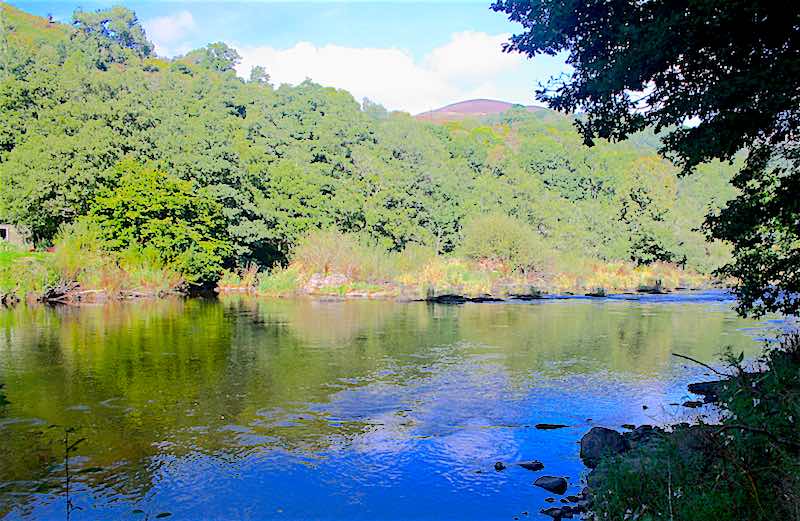
Gravel Bars & Beds:
Towards the end of the season, salmon often seek out gravel beds in the upper reaches of rivers. These areas are essential for their reproductive cycle. Identifying these beds and the pools nearby can lead to fruitful fly fishing opportunities during autumn.
Confluences:
Pools where two streams or rivers merge can be highly productive. These confluences often concentrate salmon, as they provide ideal resting spots and access to different feeding opportunities. The mixing of water temperatures and currents can make these areas a salmon magnet.
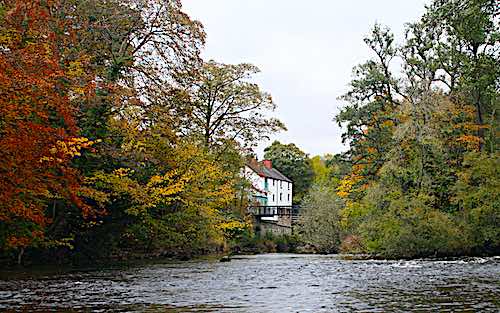
Patience and Observation:
Finding the right salmon pool often involves patience and spending time studying the river’s features and characteristics. By paying attention to flow, depth, temperature, oxygen levels, and other factors, you can identify prime salmon lies and increase your chance of catching one of these magnificent creatures.
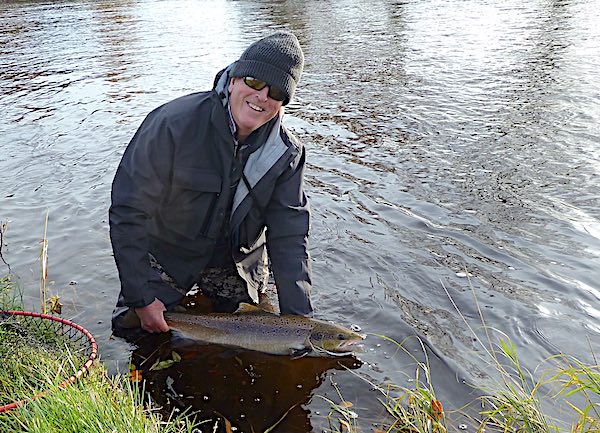
Salmon Pools on the Welsh Dee at Llangollen
I have produced a series of comprehensive fishing guides on how to fish the main pools on the Welsh Dee managed by Llangollen-Maelor Angling.
For visiting anglers, these pool guides show where to focus your fishing effort to optimise your chances of catching a salmon on the fly. Each guide contains a sketch of the pool highlighting its structural features, an indication of where salmon typically lie and the river level range that produces the best result.
If you’re starting fly fishing for salmon, I recommend focusing on fishing the following pools because they are salmon hot spots and relatively easy to fish with the fly.
Fishing these pools and studying the guides will help develop skills in identifying potent salmon lies and increase your chances of catching one.
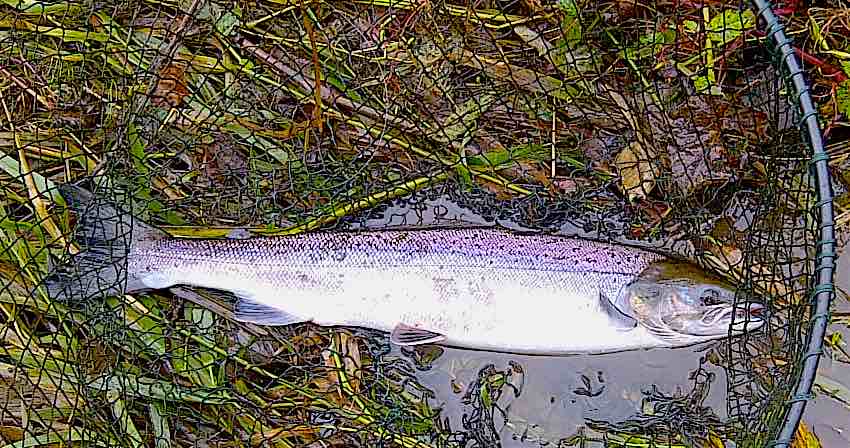
Conclusion
Salmon fly fishing in autumn promises an exciting and rewarding adventure for anglers of all backgrounds. Armed with insights into prime fishing locations, the best fly patterns for the season, and a well-designed leader setup, you’re now equipped for a memorable experience. While pursuing your passion for autumn salmon fly fishing, remember to respect the river, adhere to local regulations, and don’t forget to enjoy the breathtaking natural beauty of the Welsh Dee.
Final Note
I hope you found this post on fly fishing for salmon helpful and interesting. If you have any further questions please let me know via the comment section. I will do my best to answer them.
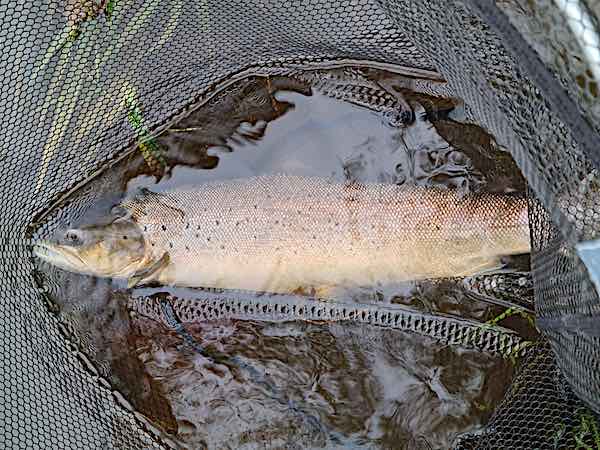
Great information ! I am just looking to learn to get started to fish for Salmon and this site has been very useful
Hi Alan,
Please to hear you are finding it useful.
I hope it helps you catch a salmon.
Cheers, Andrew